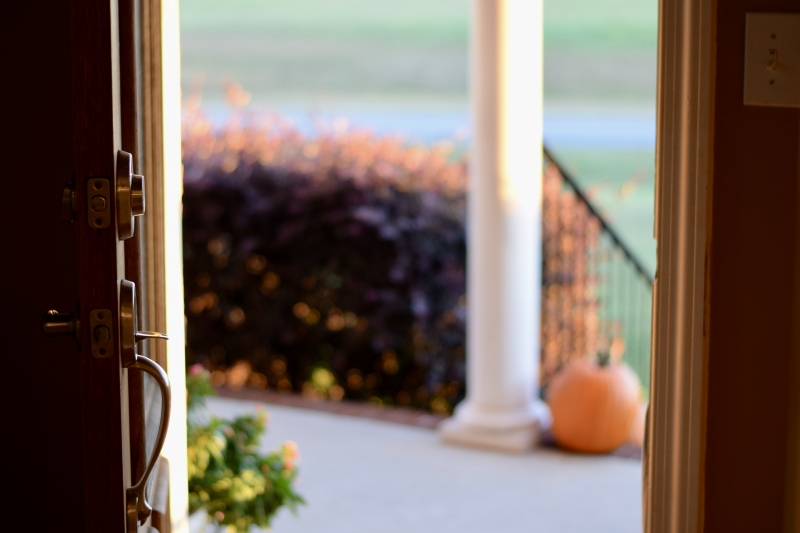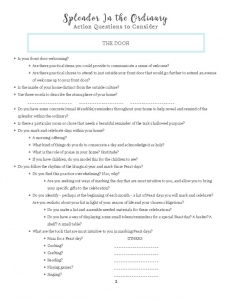Splendor In the Ordinary – The Door
This is the 2nd in a series of reading, discussing and applying ideas from Thomas Howard’s book which is available under two different names: Splendor In the Ordinary and Hallowed Be This House. If you’re new to the series, start at the Index Post discussing The Household for more explanation and a trail of breadcrumbs to the other posts in the series.
This chapter was a short one, but it certainly does help set the tone, and we bounce from deep idea to deep idea within the short pages of this chapter. Let’s explore some of these ideas!
The Door
Inside. Outside. There can be neither without a door and walls. The door separates inside from outside, and we pass through it every day. The door welcomes home mother, father, and new baby. It shelters in a storm. It opens to a neighbor in need. The door communicates that the home is a space set aside, secure, a sacred place, a haven, a domestic monastery.
“Borders and veils and doors have always marked holy places.There is a paradox here, of course: if what goes on inside a holy place has any validity at all, then it will flow out and hallow everything else…” (Thomas Howard)
This idea is the principle behind rebuilding culture. What we do in the home grows and unfolds and naturally extends.
If home is a refuge, a place of unconditional love and hospitality through service, then our actions will naturally extend through that door. We’ll take that love and hospitality with us wherever we go, and we model that to our children, so that they, too, will be ambassadors through the door.
Our domestic monastery, as a place set aside, has a very important function – to remind us through its rooms and the visual tokens we place about that our “ordinariness is actually holiness unrecognized.”
Thomas Howard likens our home and our living here as an exile of sorts. After Eden, we lost the ability to recognize holiness in the ordinary, and now we must struggle against the temptation to view it all as secular. We must struggle to remind ourselves that we are, in fact, in exile. This is not home. Yet the temptation exists when there are so many secular comforts and luxuries at our fingertips to be quite content right here and to begin to view it all as utilitarian, as secular, as luxury that is needful. We can either set roots right here (the result of which is a sticky web ensnaring us in a never-ending longing for more and more stuff), or begin to reconsider and order a space – all the spaces of our home – with reminders that it is all His. It is all veiled holiness. And it is all a gift to steward and assist us out of exile to our true home. Heaven.
And how do we do that? How can I help myself, and not just myself, but my family, to recognize the holiness and the extraordinary within the ordinary? By ordering the rooms of the home to give visual clues – breadcrumbs, reminders – that we walk daily among the extraordinary. A visual clue could be a piece of sacred art, a timer with a bell that calls the family to the Angelus, a holy card placed over the washing machine that reminds me that my Via goes through the laundry room. Because those small, tangible reminders communicate an atmosphere that it is ALL HIS. It is all gift and blessing, and gifts and blessings must be stewarded. They must be considered, offered, and placed in His service.
These visual breadcrumbs are the perfect place to start, but there is another important way to change the ordinary things we do on the inside of the door – whether that is cooking or playing games or reading – into something extraordinary.
Marking the Days
As we move through the chapter from a discussion on the door – the meaning of a closed door signifying that there is an inside that is rightly ordered and protected from chaos and tumult outside, and the door open in hospitality – we find ourselves entering, perhaps with a guest, behind the closed door. Mr. Howard reminds us that we “are the attendants at this shrine.”
“As is true of any holy place, this one (the home) has for its activity the marking and celebrating of what is true, and the keeping alive of the vision of what is true; namely, that all is holy.”
Initially, I considered that this directive was to inform my own attitude and sense of being within the home – to elevate my way of thinking about ordinary tasks. And it did affect a powerful shift in my own attitude over the last 10 or so years. The morning offering becomes so meaningful when I consider that as a form of marking and consecrating the day. And all my little tasks and errands and duties fold into the one thing needful – my life for yours. “Offering things up in acts of consecration and praise,” is, “what lifts those things from the heap of mere ordinariness and makes them extraordinary.” (Splendor In the Ordinary, Thomas Howard) It becomes a powerful way of stepping through a day. And, while I do think this is a significant part of the idea, as I read again, I considered more.
There are days worth marking. In following the Church calendar and living it in our home, through the ordinary tasks and in the ordinary rooms within the domestic monastery, we mark and celebrate eternal truths. These truths are shared by our big brothers and sisters in the faith, the saints, and passed down to us by a loving Mother, Holy Mother Church, and they teach in small ways. To consider this a form of “saint worship” would be to misunderstand the rich beauty and example the saints give us. Like the Blessed Virgin at the wedding feast of Cana, they echo, “do whatever He tells you.” These feasts of the Church celebrating Saints and seasons show us the way out of this exile. They point us home. This is a truth we can mark and celebrate. How that looks may be different from home to home depending on talent and means. We may mark the day by going to Mass, cooking, reading stories, crafting, or playing games, and in doing so, we allow these Feast days to become “bearers of the divine mysteries and glory to us.” (Splendor in the Ordinary, Thomas Howard).
All the doors in your home
As I pondered this chapter, it occurred to me that there are many doors in our homes. The front door, the back door, and other doors, that while not literal doors, are doors that swing open and closed nonetheless and we would do well to consider them and guard them.
I suppose we think of the door as the big hinged rectangle usually located on the front of our home. We’ve got a nice mat out front, maybe some flowers. There’s a deadbolt so we’re safe from the storms and tumult outside. But is that the only door in your home? I write and you are reading from a very different place than perhaps Thomas Howard had in mind when this book was first penned in 1977. Here I sit pouring my thoughts out for you on a blog which will reach you through the internet, perhaps email, Facebook, Instagram, Twitter, or some other digital door. Technology provides a myriad of these digital doors, many of which are in our homes (and hands) and they swing wide open with ease. While the front door is concrete and we can tend it and open it and close it, these doors which open to digital realms are not so tidy nor so easily seen. But make no mistake, they are a place of coming and going and the very same principles must apply.
I know this is a landmine of a topic, but these digital doors most certainly swing open and closed and I can’t ignore it, and neither can you, dear friends. I am not an expert, nor do I speak from that perspective. I’m a mom of adult kids down to little kids with kids in between. This is a question we’ve grappled with and revisit regularly. I offer a few ideas for you to consider.
The realm beyond these digital doors is wide and heavily trafficked. I’m not going to give you black and white guidelines that imply a do-this-and-no-harm-will-come-through-that-digital-door principle because they simply don’t exist. Just as I can’t promise you that if you erect a strong solid steel door on your home no ill will ever befall you. Ignoring and eschewing doors does not offer protection. It only invites motivation to explore outside a door…with no guidance. The virtue of prudence exists so that we can exercise it for our individual family and seek what is best for our family in a given season. Make use of prudence (it’s a virtue!!) and lean heavily into the graces given through the Sacrament of Matrimony.
To be clear, I do not eschew doors – digital or concrete. In fact, I walk through them both regularly. And I allow my children to do so. With the physical doors in our home, there is a measure of graduated movement when my children walk through a door. At first, I may allow a child out to play in the yard while I watch nearby. As that child gets older, he may go out with siblings while I watch from a window. Still older, he goes out with friends, and then on his own, and one day he’s off and driving and going farther and farther away, but always with guidance and a clear idea of where he is going, how to get there, and how to get back home.
The digital doors in my home function similarly. I use them regularly so that I can be familiar with the territory and because I have always delighted in sharing the extra, the overflow that can extend from my home through these digital doors. With my children, the same graduated movement principle applies. At first, I walk with my children, and then little by little, we let them move through those doors until there is a maturity and readiness to walk through the doors without accompaniment. There is always guidance, watchfulness, prudence, and while there is much good to be found on the internet, there is also clear direction given on the dangers outside that door.
We don’t live in cloistered communities. We’re called to be in the world, not of it, to be the salt and light and you need doors that open to bring the light of Christ to a dark world. I pray we can all find a way to close these digital doors in prudence when necessary and open the doors in hospitality when possible – and model the same to our children. The internet is in need of baptizing.
A small practical note: our family has found a small device known as The Circle to be a wonderful “digital doorkeeper” in helping with the practicals. It’s something used by the entire family and monitored through an app. Think of this tool as identifying every single open digital door so that you, as a parent, can know the comings and goings and how much time is spent there. And, you, as the parent, can decide to permanently close certain digital doors, while leaving others safe to open. It’s a way of throwing light onto everything, and I believe it’s a universal principle that things done in the light are far safer than those cloaked in darkness and secrecy.
And where would a door be without…
…walls? And that’s where we’ll pick up next week! With the four walls.
Questions to Consider
I received some feedback about the questions I left at the end of last week’s post. Several of you asked me to expand them, and I’ve decided to do so in the form of a printable file. I’ll update the file each week with a new printable reflecting questions from the week’s chapter. My hope is that these questions will be a way for both you and me to consider the deep ideas here and work our way toward action steps we can take to recognize the splendor within our ordinary.
Click the image below to open and download the printable Action Questions.








Wow Jennifer! Such a great post! I have some thoughts swirling around in my head but I want to come back and read your post again later today and take some notes. 🙂 I’ll try to comment more then. And thank you, thank you, thank you for the printable set download! I will be printing them out today!
Finally made it back to comment! A couple of quotes from this chapter that I highlighted:
“There is an inside here, protected from mere randomness and clutter, in which things begin to be set in their proper order and seen in their true light.” (p. 24)
“Holy things are ordinary things perceived in their true light, that is, as bearers of the divine mysteries and glory to us.” (p. 25)
I appreciate that the author continues to impress upon the reader that the ordinary can be hallowed. These particular quotes continue to build on that concept…but he also points out the idea of proper order of things.
I appreciate how you brought out the idea that we can have visual reminders throughout our home to help us remember this hallowedness in the ordinary. Thank you for giving concrete ideas of this as well. It got me thinking of little ways to add upon what we already have around our home.
And digital doors – what an great point!
Here are some things you said in your post that I really appreciated and jotted down in my notebook:
“How can I help myself, and not just myself, but my family, to recognize the holiness and the extraordinary within the ordinary? By ordering the rooms of the home to give visual clues – breadcrumbs, reminders – that we walk daily among the extraordinary. A visual clue could be a piece of sacred art, a timer with a bell that calls the family to the Angelus, a holy card placed over the washing machine that reminds me that my Via goes through the laundry room. Because those small, tangible reminders communicate an atmosphere that it is ALL HIS. It is all gift and blessing, and gifts and blessings must be stewarded. They must be considered, offered, and placed in His service.”
“In following the Church calendar and living it in our home, through the ordinary tasks and in the ordinary rooms within the domestic monastery, we mark and celebrate eternal truths…These feasts of the Church celebrating Saints and seasons show us the way out of this exile. They point us home.”
“The morning offering becomes so meaningful when I consider that as a form of marking and consecrating the day.”
Could you elaborate more on the morning offering? I assume you are speaking about your personal time in the morning, maybe your Mother’s Morning Basket as well?
I love your thoughts! And your quotes from Splendor are among my favorites, too!
The morning offering is the first of a series of prayers I say every single day – even before I get out of bed. In the morning offering I offer my entire day to Jesus – all of it – my prayers, works, joys, and sufferings. It’s that consecration of the day that Thomas Howard speaks of and it sets the tone for my entire day. It is all His. And it’s my job to cooperate with as much grace as I possibly can! And after my Morning Prayers I go right into my Mother’s Morning Basket reading.
Thank you for this series, I managed to buy the book on kindle and I am following along with you. I will enjoy it I know! It has come at just the right moment for me as I was searching for some spiritual reading to give me a boost. I love the concept as the home as a sanctuary, a harbour of peace and spiritual nourishment. I will definitely think more on the points you raised and comment again.
I just wanted you to know you are not reading alone:)
I’m so glad you’re along!!
I too am reading your posts about this book, Jennifer, although my actual copy of the book hasn’t arrived yet. Your words are deep and need reflection but I am struck by the depth of your faith, day by day. I emailed you with some more personal thoughts last week because I am so deeply touched by your faith. Keep up this wonderful blog and, of course, sharing your interpretations of Thomas Howard’s book.
I think that the quote I most identified with in this chapter was “We have a hard time keeping this vision alive, and we have to pluck ourselves by the sleeve, so to speak, in order to stay awake to the fact that we do walk among the hallows.”
I definitely identify with this – I get (and have gotten more so recently) so caught up in the day to day living that I am essentially sleepwalking. And it’s this sleepwalking, I think, that makes time just speed by. I pause and months have gone, and I don’t know where they went. I find that when I consciously honor special times and disciplines, it slows time down. I am awake and paying attention and intentional. So glad I found this book – it is figuratively plucking at my sleeve to wake up again.
Also, thank you for sharing your thoughts on digital doors. As someone who spends a lot of time on the computer, it’s encouraging me to look at those doors to see if they need different “open” times.
Kendra